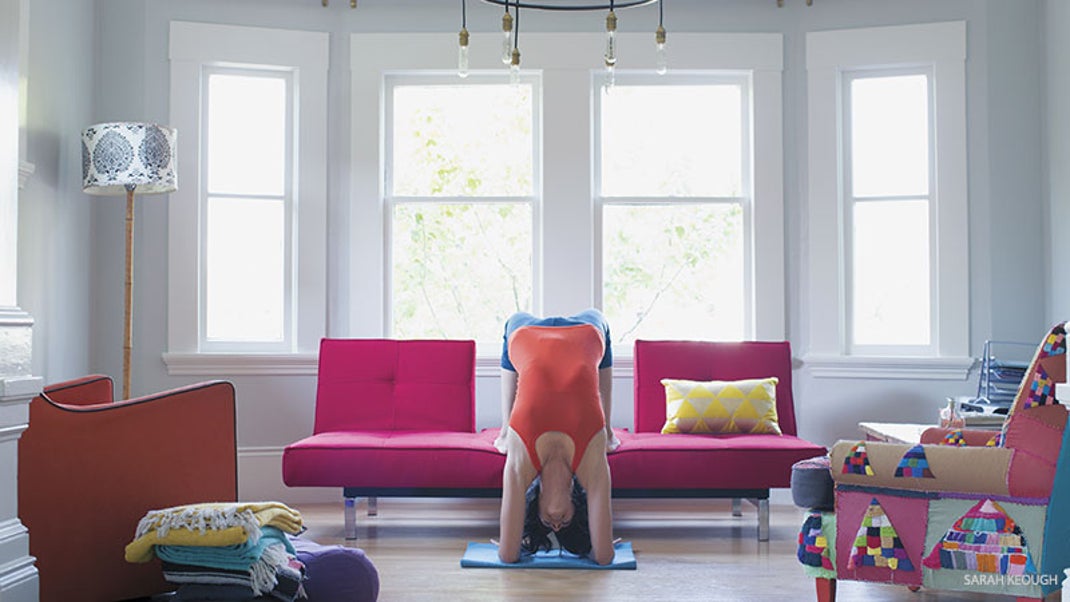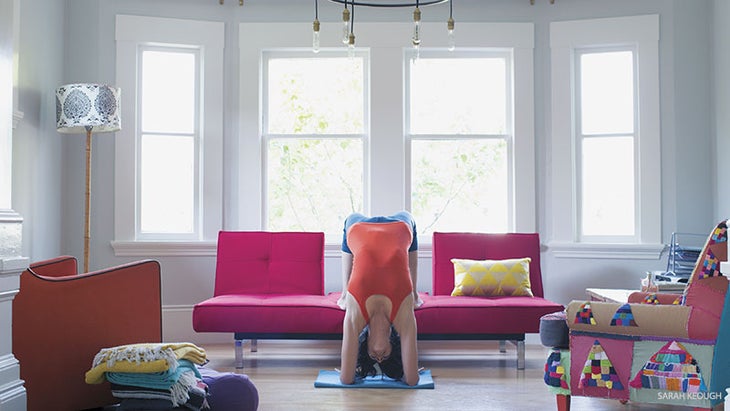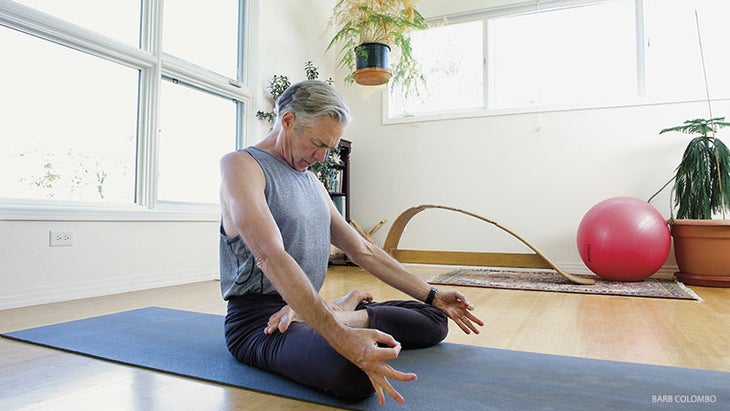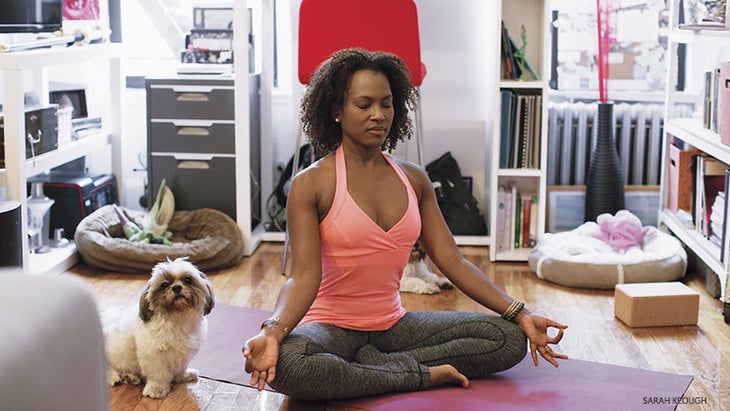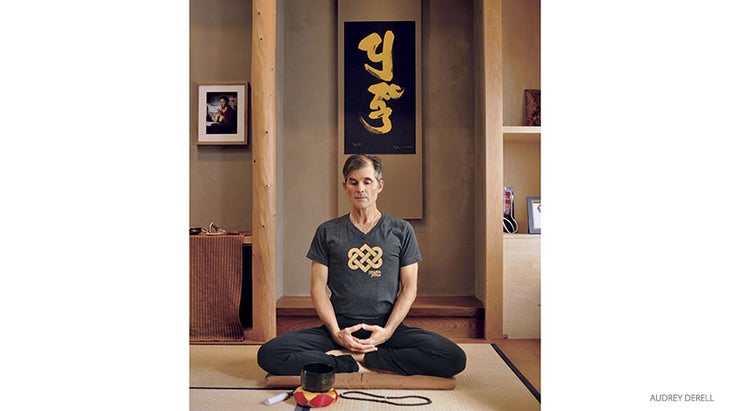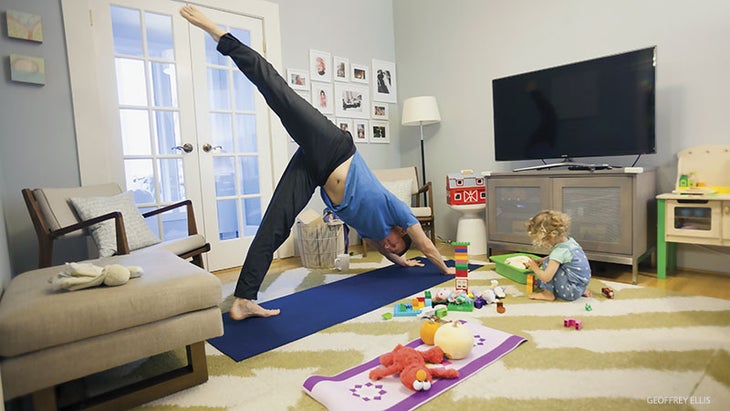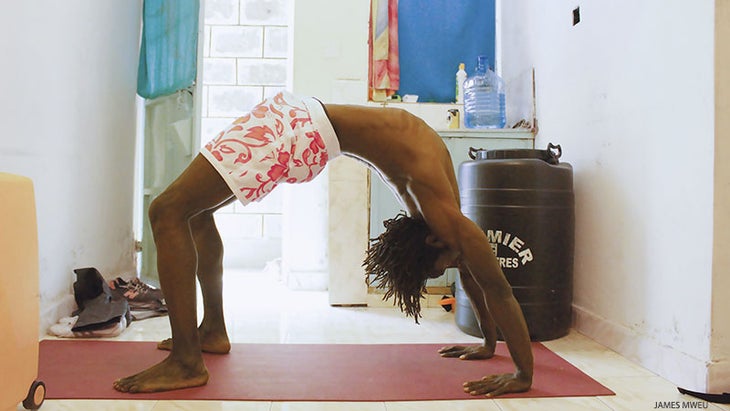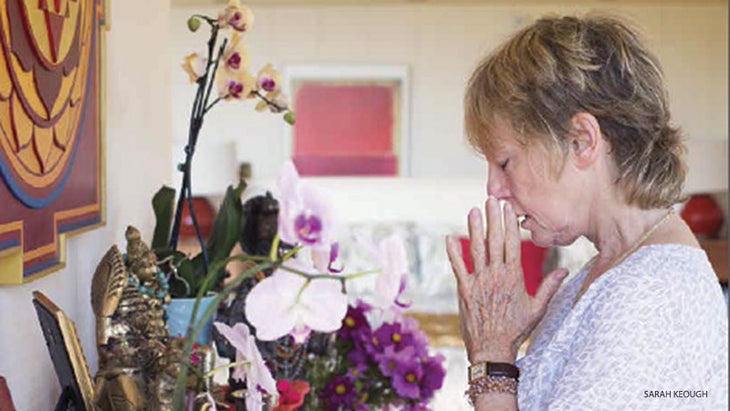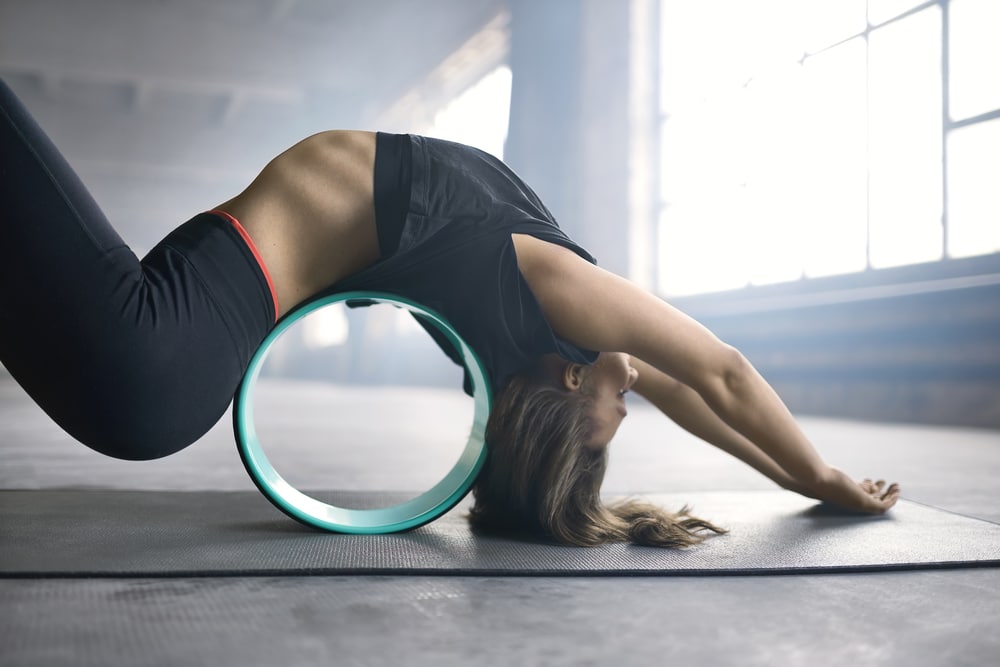Are you trying to create space for a dedicated home practice? Dedicating time and energy to your yoga, meditation or other self-care practices can be one of the best investments that you make in yourself.
It is important to take care of our mind, body, and spirit as we go through the day-to-day challenges of this life. Creating an environment at home that supports your inner work will allow you more freedom in choosing how often and when during the day you do these practices.
Get advice from the world’s best yoga teachers on how to craft a special practice space in your home.
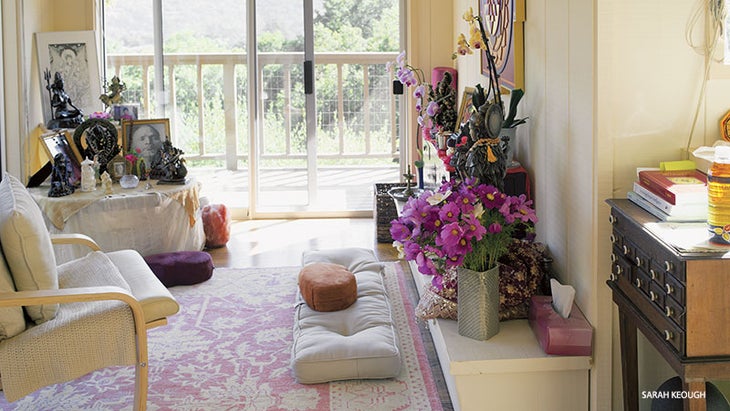
More than 50 yoga teachers and practitioners invited us into their homes to share their personal practice spaces and habits for the new Yoga Journal–presented book Yoga at Home: Inspiration for Creating Your Own Home Practice, by Linda Sparrowe. Here, a sneak peeks at some of their stories to inspire you to create your own dedicated yoga space and embrace a practice that works for you.
Margi Young
Oakland, California
Margi Young, an OM Yoga instructor who teaches classes and workshops worldwide, confesses that knowing it’s time to practice doesn’t mean it’s easy to get on her mat at home.
There is absolutely nothing I love more than to be on my mat exploring my body and breath. But, in the spirit of Satya (truthfulness), I must admit that most days it’s a struggle to practice at home. Why? First, I’m not a morning person. I know the ancient yogis say that we have the ability to change ourselves and create new samskaras (patterns), but every time I force myself to get up early to practice, I fall back to sleep on my mat. I finally decided that it’s OK not to practice in the morning, and that’s a samskara I can accept.
Second, practicing in my house is challenging for me. When I teach yoga retreats and training away from my “normal life” of computers, family, work, dishes, and shopping—when the only things on the agenda are yoga, teaching, and eating—my practice is an uncomplicated delight. But when I’m at home, there’s a mental and physical journey I have to take between the thought “It’s time to practice” and rolling out my mat. Once I finally get to that point, here are some things that help me practice:
I practice any time from 8 a.m. to 11 p.m., and once on my mat, I can usually sink into a deep practice with restorative poses. I set a timer and commit to a set amount of time, and it doesn’t matter whether it’s 15 minutes or 90 minutes. That timer sets a very clear boundary and helps me to commit to staying on my mat. I keep a notebook next to my mat. When I think of tasks during my practice, instead of popping off my mat into action, I jot them down to deal with later. That way, I can continue to stay focused on my yoga. I usually end up with a list of phone calls to make, emails to write, and dust bunnies to destroy.
I try to do a 20-minute Savasana every day. That can happen on my mat or in my bed or in someone else’s living room, but I practice the alignment of Savasana and I work with my breath and my mind. My practice also sometimes involves reading a spiritual text or listening to an online dharma talk.
I let go of the “shoulds” of sequencing. I know oh-so-well how to sequence a class for others, but for myself, I can put the rules aside. I might come into Lotus without any hip openers, or do Savasana in the middle of a sequence. I let my body guide me. It’s great fun when I can fully get out of my own way and let my body do the sequencing and teaching.
I now understand that my home practice happens off the mat as much as on. Can I let go of my agenda and listen to my husband and child? On the street, can I make eye contact with someone who appears to be suffering? Can I sprinkle in a little extra kindness to the barista making my beverage? Can I empty my own mind to be more present for my students? Can I remember to breathe deeply when life begins to feel like a tornado? Can I slow down and enjoy the journey instead of living in my habit to rush? I ask myself these types of questions every day.
Richard Freeman
A Boulder, Colorado-based yoga teacher and co-owner of the Yoga Workshop.
“When we remodeled our house 11 years ago, we created two rooms exclusively for yoga. We rarely do a complete practice any other place in the house, but we will often spontaneously do yoga poses in any room, especially halfway up one of the staircases. The house is one big yoga prop.”
Faith Hunter
New York City and Washington, DC
As the creator of Spiritually Fly, yoga teacher Faith Hunter uses chanting, music, breath, and movement to encourage her students to embrace their unique flow in the classroom and beyond.
When I practice at home, I truly listen to and honor where I am emotionally and physically. Some days my practice is restorative and healing, and other days it is a more fluid, high-energy experience.
The practice of yoga has provided and continues to provide comfort, balance, and steadiness during challenging moments. I always know my practice is there, holding a space for my heart. When I do feel challenged, I typically start with a short meditation that I do in bed when I first wake up.
It gets me going and provides focus when those uncomfortable thoughts creep in. The meditation includes a little visualization and ends with giving thanks. This approach sets the tone for my day and inspires my body to move.
I recently returned to New York City. My current home is a cute junior one-bedroom apartment that is also my home office. My space is very personalized. I have an altar with family photos, flowers, pillows, yoga props, mats, lots of books, and other memorable items I’ve collected over the years. I’m also inspired by my two adorable Shih Tzus, Yoshi, and Sebastian, moving around the apartment. I love watching them shapeshift into Upward-Facing and Downward-Facing Dog.
Practicing alone gives me the opportunity to explore who I am on an intimate level, the time to dive deeper into my meditation practice, and the freedom to move in a way that feels natural to me.
Her Practice Advice
- Start simple. Don’t overwhelm yourself with long practices and complicated sequences.
- Select a practice time that fits your lifestyle. If you are not a morning person, don’t plan to practice at 6 a.m.
- Create a dedicated space, and place items in it that inspire you.
Flow with Faith
Follow this short vinyasa that Hunter incorporates into her home practice. “After a brief meditation, some targeted breathwork, and a few simple movements, I jump into this flow,” she says. Give it a try.
Stand at the top of your mat, hands resting at your heart. Inhale, feeling the beauty of your life pour in, and then exhale, slowly creating space for abundance. Inhale and lift your arms overhead, palms touching.
Exhale forward, step your right foot back for Anjaneyasana (Low Lunge); inhale your arms overhead. Exhale, release your hands, and draw your hips back to stretch your hamstrings.
Inhale, bend your knee, and exhale your right arm to the sky for a spinal twist. Release and step into Adho Mukha Svanasana (Downward-Facing Dog Pose).
Inhale to Plank Pose; exhale your knees, chest, and chin toward the mat. Slide forward into a low Bhujangasana (Cobra Pose), and then shift your hips back into Balasana (Child’s Pose).
Curl your toes under and move into Downward-Facing Dog. Inhale and walk your feet to the top of the mat.
Breathe in and soften your knees. Roll up to standing and return your hands to your heart. Repeat sequence on the other side.
Tias Little
Santa Fe, New Mexico
Tias Little and his wife, Surya, created Prajna Yoga, a profound journey inward. Through yoga poses, dharma study, guided meditation, the yoga of sound, and somatic awareness, their practice allows for unique, personal transformation.
My wife, Surya, and I built our dream practice space, from the ground up, on our 10-acre parcel of land outside Santa Fe. Built by a yogi carpenter, Robert LaPorte, and designed by his wife, Paula Baker-LaPorte, our home studio complements and enhances the mindfulness of the yoga experience. They used non-toxic materials and natural finishes, and the mud walls are made of straw-clay. In building our practice space, we wanted to create a living structure that amplifies, not detracts from, the prana (life force) within the practice space.
The studio has unique windows, situated to allow a glimpse of the natural world outdoors. Within the space, we’ve placed elements that remind us of the raw, nonlinear beauty of nature—black river stones, a gnarled juniper bough, irregular pieces of sandstone moss rock. Like Zen temples in Japan, where a spare and pleasing aesthetic inspires the mind to go still, our practice space often elicits deep calm.
I always do home practice. I don’t like to leave my home until I commune with my inner guides, allies, and angels. When I do not yoke to the presence of the spirit inside and breathe life into my pranic sheath, then I am prone to distraction, irritation, or carelessness throughout the day.
The pressures of the world and the demands of people tend to wither the pranic sheath. When our prana is depleted and our vitality is weakened, we are prone to disease of all kinds. The practice provides not only a physical buffer but also a kind of psychic shield. We practice so that, ultimately, nothing can knock us off the center of our day.
I am a morning practitioner. I get up, take a pee, and go right to the meditation cushion in my practice space. This is when I am most permeable and open to the small voice of the Unspeakable Spirit that dwells within. This is the time before the recycling truck goes barreling down the road and the neighbors take their morning walks, yapping on cell phones.
This is a time when my pulse is soft, my heart rate is slow, and my mind is a little bit empty. In morning meditation, I track my dreams. After 25 years of doing yoga, much of my practice is focused on the subtle (and not-so-subtle) churnings of my depth psyche. Impressions of fear, shame, and pride bubble up in the Dreamtime. By sitting with the afterimages of dreams, I catch glimpses of my shadow. Early morning practice is best for being with the outlines of the shadows that surface in my dreams.
For me, it is paramount to ride the changing edge of being, for I am always in a state of becoming, never static. Thus, the practice should never simply be routine. For instance, I started in Ashtanga Yoga when I was in my early twenties. Now that I am over 50, I do a very different practice. I believe the practice should always stay fresh, creative, and interesting. It is only routine in that discipline and consistency are required to step onto the mat every day.
However, as we age, we must skillfully conform our practice to be in accord with the changes that happen in our bodies, minds, and spirits. In this sense, the practice should always be evolving.
Jason Crandell
Yoga teacher based in San Francisco
“Our living room is our daughter’s favorite room to practice in, so this usually means forward bends and hip openers while playing with Legos or doing crafts. I love it because it feels like an honest, comfortable time with my family.”
Kevin Ogutu
Africa Yoga Project teacher based in Nairobi, Kenya
“My yoga mat makes me practice.I leave it spread out. I get out of bed and step right onto the mat. I might not be in a mood to practice, but once I stand on the mat, I do it.”
Sally Kempton
Meditation teacher and author in Carmel Valley, California
“Daily meditation is an opportunity to check in regularly with the peace behind the mind, and, as you practice it, the mind becomes more focused, manageable, calm, and creative.”
Her practice advice
- Use the space you have, make the practice as portable as possible, and, above all, create a habit. Surround your practice with beauty to make it attractive.
- Don’t feel that you have to do a full practice if your time is short. Even doing one asana or 10 minutes of meditation is better than no practice at all! Create a short practice, a medium practice, and a long practice so you can alternate depending on the time you have.
- Reading a spiritual book can also be a huge inspiration at the beginning and end of a practice.
Conclusion:
Creating a dedicated home practice space is important for many reasons. It allows you to have a consistent place and time to practice, which can be helpful in establishing the habit. It also provides a physical and psychic buffer against the demands of the world.
The practice should always be fresh, interesting, and evolving to reflect the changes that occur in our bodies, minds, and spirits as we age. Reading spiritual books before or after your practice can be an inspiration and help keep you on track. Namaste!
